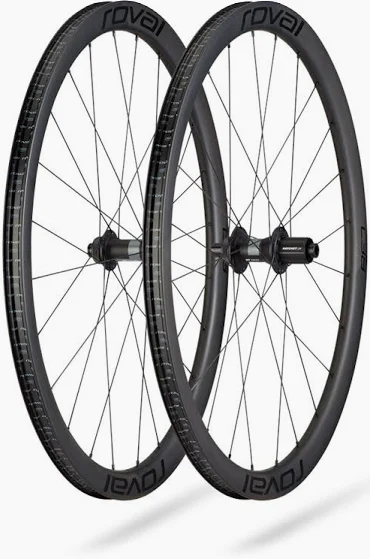Whether you’re an avid cyclist or just starting out, upgrading the wheels on your bike can have a profound impact on your overall riding experience. In this article, we will take you through a comprehensive guide to the various types of carbon wheels available, helping you make an informed decision when it comes to selecting the perfect set for your bike. From understanding the different types of carbon materials used to the various rim depths and widths, this guide will equip you with the knowledge you need to elevate your cycling performance to new heights. Get ready to discover the world of carbon wheels and revolutionize your biking journey.
Table of Contents
ToggleTypes of Carbon Wheels
Choosing the right type of carbon wheels for your bike can greatly enhance your cycling experience. Carbon wheels are known for their lightweight, stiffness, and aerodynamic properties, making them a popular choice among cyclists of all levels. In this article, we will explore the various types of carbon wheels available in the market, their unique characteristics, and how they can impact your riding performance.
Clincher Wheels
Clincher wheels are one of the most common types of carbon wheels and are widely used by cyclists in different disciplines. These wheels feature a bead on the edge of the tire that hooks onto the rim, securing it in place. This design allows for easy installation and removal of tires, making it convenient for both amateurs and professional cyclists. Clincher wheels are compatible with a wide range of tire options, making it versatile for various road conditions and terrains.
Tubular Wheels
Tubular wheels, also known as sew-up wheels, have been the traditional choice for professional cyclists for many years. They consist of a tubular tire that is stitched around the inner tube and then glued to the rim. Tubular wheels offer a smoother ride, better cornering abilities, and lower rolling resistance compared to clincher wheels. However, they require a more labor-intensive installation process and can be challenging to repair on the road.
Tubeless Ready Wheels
Tubeless ready wheels are gaining popularity among cyclists due to their ability to eliminate the need for inner tubes. Instead, these wheels use a special tire and rim combination that creates an airtight seal, allowing you to run lower tire pressure for improved comfort and traction. Tubeless ready wheels also offer better puncture resistance and reduce the risk of pinch flats. However, they require the use of a liquid sealant to prevent air leakage and may require additional maintenance compared to other types of wheels.
Rim Depth
The rim depth of carbon wheels refers to the height of the rim, which can vary from shallow to deep sections. Each rim depth offers unique advantages and considerations that can influence your riding performance.
Deep Section Wheels
Deep section wheels have a rim depth of 40mm or more, making them highly aerodynamic. These wheels are popular among time trialists and triathletes who prioritize speed and efficiency. The deep rim profile reduces drag by cutting through the wind, allowing cyclists to maintain higher speeds with less effort. However, deep section wheels can be more challenging to handle in crosswinds and may not be as responsive in steep climbs.
Mid Section Wheels
Mid section wheels typically have a rim depth between 30mm and 40mm, offering a balance between aerodynamics and handling. These wheels are suitable for a wide range of riding disciplines, including road racing, endurance riding, and even some off-road applications. Mid section wheels provide a good compromise between speed and stability, making them a versatile choice for different riding conditions.
Shallow Section Wheels
Shallow section wheels have a rim depth of less than 30mm, prioritizing lightweight and agility over aerodynamics. These wheels are commonly used in climbing, where weight savings are crucial for maintaining speed on steep ascents. Shallow section wheels are also popular among recreational riders who value maneuverability and responsiveness. However, they may not offer the same aerodynamic benefits as deeper rims and can be less stable at high speeds.
Rim Shape
The shape of the rim plays a significant role in the aerodynamic properties of carbon wheels. Different rim shapes are designed to optimize airflow and reduce drag, leading to improved speed and efficiency.
V-Shaped Rims
V-shaped rims feature a pointed profile that resembles the letter “V.” These rims help to guide the airflow smoothly over the wheel, reducing turbulence and drag. V-shaped rims excel in straight-line speed and are commonly used in time trials and triathlons. However, they may be less stable in crosswinds and require careful handling.
U-Shaped Rims
U-shaped rims have a more rounded profile, resembling the letter “U.” These rims offer similar aerodynamic advantages as V-shaped rims but provide enhanced stability in crosswinds. U-shaped rims are popular among road racers, criterium riders, and cyclists who value a balance between speed and handling capabilities.
Flat Rims
Flat rims have a more squared-off shape, offering a balance between straight-line speed and crosswind stability. These rims are versatile and suitable for a wide range of riding disciplines, including road racing, endurance riding, and even some off-road applications. Flat rims are a popular choice among cyclists who prioritize versatility and all-around performance.
Rim Width
The width of the rim also impacts the performance and ride quality of carbon wheels. A wider rim generally offers better tire stability, improved aerodynamics, and increased comfort.
Narrow Rims
Narrow rims, typically with an internal width of 17mm to 19mm, are commonly found on older carbon wheel designs or lightweight climbing wheels. These rims are compatible with narrower tires and are known for their agility and responsiveness. However, they may not provide the same level of stability as wider rims and can limit the maximum tire volume.
Standard Rims
Standard rims have an internal width of around 19mm to 21mm, making them suitable for a wide range of tire sizes. These rims provide a good balance between agility, stability, and compatibility with various riding conditions. Standard rims are a popular choice for road racing, endurance riding, and general cycling purposes.
Wide Rims
Wide rims, with an internal width of 21mm or more, have become increasingly popular in recent years. These rims offer better support for larger tires, allowing you to run lower pressures for increased comfort and traction. Wide rims also improve aerodynamics, as they create a smoother transition between the tire and rim, reducing drag. However, they may require specific tire sizes and can add weight to the wheel.
Spoke Patterns
Spoke patterns play a crucial role in the overall strength, stiffness, and durability of carbon wheels. The arrangement and tension of the spokes can impact the lateral rigidity, vertical compliance, and resistance to torsional forces.
Radial Spoke Pattern
The radial spoke pattern is characterized by spokes that radiate straight from the hub to the rim, intersecting without crossing each other. This pattern offers excellent lateral stiffness, providing responsive acceleration and direct power transfer. However, radial spoke patterns can be less forgiving on rough road surfaces and are more susceptible to damage from impacts.
2-Cross/N-Step Spoke Pattern
The 2-cross, or sometimes referred to as N-step, spoke pattern involves each spoke crossing one or two other spokes before reaching the rim. This pattern improves the overall strength and durability of the wheel, allowing it to withstand greater forces and impacts. The 2-cross/N-step pattern offers a good balance between responsiveness and resilience, making it suitable for a wide range of riding disciplines.
3-Cross/N-Step Spoke Pattern
The 3-cross/N-step spoke pattern involves each spoke crossing three or more other spokes before reaching the rim. This pattern provides even greater strength and durability, making it ideal for heavier riders, off-road applications, or challenging terrains. The 3-cross/N-step pattern offers excellent lateral and torsional stiffness, ensuring stability and control in demanding riding conditions.
Hub Types
The hub is the central component of the wheel that houses the bearings and attaches to the bike’s frame. Different hub types offer varying levels of ease of use, compatibility, and performance characteristics.
Quick Release Hubs
Quick release hubs feature a lever system that allows for easy and quick installation and removal of the wheels. These hubs are popular among cyclists who frequently remove their wheels for transportation or maintenance purposes. Quick release hubs are compatible with most road and mountain bikes, making them a versatile option.
Thru-Axle Hubs
Thru-axle hubs use a larger diameter axle that threads directly into the bike’s frame, providing improved stiffness and stability. Thru-axles offer enhanced handling and responsiveness, especially in demanding off-road conditions or high-speed descents. Thru-axle hubs are becoming increasingly common in modern road and mountain bikes.
Center Lock Hubs
Center lock hubs feature a unique spline interface that allows for easy and secure attachment of disc brake rotors. This system provides quick and hassle-free rotor installation and removal, making it convenient for riders who frequently switch between disc brake setups. Center lock hubs are commonly used in disc brake-equipped road and mountain bikes.
Braking Surface
The braking surface of carbon wheels refers to the part of the rim that comes into contact with the brake pads. Different materials and treatments can affect the braking performance, durability, and heat dissipation capabilities of carbon wheels.
Carbon Rim Braking Surface
Carbon rim braking surfaces offer a lightweight and aerodynamic advantage, ideal for riders looking to optimize speed and efficiency. Carbon braking surfaces generally require dedicated carbon-specific brake pads to ensure optimal stopping power and prevent excessive wear and heat buildup. It’s essential to follow the manufacturer’s recommendations for brake pad compatibility, installation, and maintenance to ensure safe and optimal braking performance.
Aluminum Rim Braking Surface
Some carbon wheels feature an aluminum braking surface, which combines the lightweight properties of carbon with the reliable braking performance of aluminum. Aluminum rim braking surfaces provide consistent and predictable stopping power in various weather conditions and are compatible with standard brake pads. They offer improved braking modulation and are more forgiving on prolonged descents or heavy braking situations.
Ceramic Rim Braking Surface
Ceramic rim braking surfaces are commonly found in high-end carbon wheels, offering superior heat dissipation and prolonged braking performance. These braking surfaces consist of a layer of ceramic material applied to the carbon rim, reducing heat buildup and improving overall braking efficiency. Ceramic rim braking surfaces are less prone to wear and provide consistent braking in both wet and dry conditions. However, they often come with a premium price tag.
Weight
The weight of carbon wheels is a crucial factor to consider, as it directly affects your bike’s overall weight, acceleration, and climbing abilities. Different weight categories cater to specific riding preferences and disciplines.
Lightweight Carbon Wheels
Lightweight carbon wheels are designed to minimize weight while still providing adequate strength and performance. These wheels excel in climbing and acceleration, allowing you to conquer steep ascents with ease. Lightweight wheels are often preferred by climbers, competitive racers, and riders who prioritize weight savings over other factors.
Standard Weight Carbon Wheels
Standard weight carbon wheels strike a balance between lightweight construction and durability. These wheels are suitable for a wide range of riding disciplines and offer a good combination of climbing abilities and overall performance. Standard weight wheels are often chosen by endurance riders, all-rounders, and cyclists who value versatility.
Heavy Duty Carbon Wheels
Heavy-duty carbon wheels prioritize durability and strength over weight savings. These wheels are designed to withstand more aggressive riding styles, challenging terrains, and heavier loads. Heavy-duty wheels are commonly used by downhill riders, gravity racers, and riders who prioritize strength and reliability in demanding conditions.
Aerodynamics
Aerodynamics play a significant role in improving speed and reducing drag, especially at higher speeds. Carbon wheels are known for their aerodynamic benefits, and different models offer varying levels of aerodynamic performance.
Aero Carbon Wheels
Aero carbon wheels are specifically designed to minimize drag and maximize speed. These wheels feature deep section rims, streamlined profiles, and optimized spoke patterns to slice through the wind with minimal resistance. Aero wheels are popular among time trialists, triathletes, and cyclists who prioritize top speed and aerodynamic advantages.
Standard Carbon Wheels
Standard carbon wheels, while not specifically designed for pure aerodynamics, still offer noticeable aerodynamic benefits compared to traditional alloy wheels. These wheels feature a balance between weight savings, stiffness, and moderate rim depths, making them suitable for a wide range of riding disciplines. Standard carbon wheels provide a noticeable improvement in aerodynamic performance compared to non-aero wheels.
Price Range
The price range of carbon wheels can vary significantly based on factors such as materials, manufacturing processes, brand reputation, and specific features. Understanding the different price ranges can help you make an informed decision based on your budget and performance requirements.
Entry-Level Carbon Wheels
Entry-level carbon wheels offer an affordable option for cyclists who want to experience the benefits of carbon without breaking the bank. These wheels often feature simpler designs, lower weight savings, and may not have the same level of aerodynamics or performance as higher-end models. However, they still provide a noticeable improvement over alloy wheels and can be a great entry point into the world of carbon wheels.
Mid-Range Carbon Wheels
Mid-range carbon wheels strike a balance between performance and price. These wheels offer a combination of lightweight construction, aerodynamic features, and durability, making them suitable for riders who want to upgrade their performance without making a significant financial commitment. Mid-range carbon wheels often provide a good compromise between price, performance, and versatility.
High-End Carbon Wheels
High-end carbon wheels represent the pinnacle of performance, incorporating the latest technologies, advanced materials, and meticulous craftsmanship. These wheels offer top-of-the-line aerodynamic properties, exceptional weight savings, and precise manufacturing tolerances. High-end carbon wheels are designed for competitive cyclists, professionals, and riders who demand the best performance and are willing to invest in top-quality equipment.
In conclusion, choosing the right type of carbon wheels for your bike can have a significant impact on your riding performance. Understanding the different types of carbon wheels, including clincher wheels, tubular wheels, and tubeless ready wheels, can help you make an informed decision based on your riding preferences and requirements. factors such as rim depth, rim shape, rim width, spoke patterns, hub types, braking surface, weight, aerodynamics, and price range should also factor into your decision-making process. By considering these factors and finding the right balance between weight, aerodynamics, durability, and price, you can find the perfect set of carbon wheels that will enhance your cycling experience and help you achieve your goals. Happy riding!







